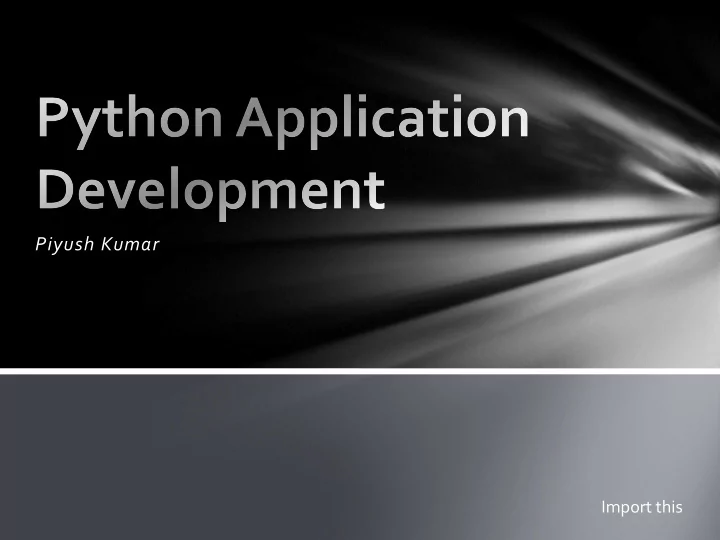

Piyush Kumar Import this
Topics Covered in this course 1.Introduction to Python 2.Data Structures 7. Functional Programming 3.Functions 8. Text Handling 4.Modules and Libraries 9. GUI Development 5.OOP 10.Graphics Programming 6.Testing / Debugging 11.Algorithms in Python 12.Web Development
Before we start… We will learn how to use mercurial and use it for any code we write in this course. This will keep a history of whatever we did for this course. So, First – An Introduction to Mercurial.
Before we start… And our editor will be eclipse… Eclipse + Pydev installation. Keyboard Shortcuts. Key Press Action Ctril+/ Comment out selection Alt+W->Preferences Change Keybindings + Everything else F11 Debug Ctrl + E Move among tabs F3 Jump to declaration Ctrl+W Close Tab Ctrl+L Jump to Line number Ctrl+M Maximize current window Tab / Shift+Tab Shift Selection Right / Left Ctrl + Spacebar Autocomplete
Introduction to Python 1.Getting/Installing Python 12. Python Statements 13. Comments 2.History 14. Variables 3.Uses 15. Keywords 4.When not to use Python 16. Upper/Lower Case 5.Invoking the Interpreter 17. Looping techniques 6.Interactive Mode 18. Indentation 19. Conditionals 7.Getting help 20. Relations 8.Eclipse + Pydev – Setup 21. Printing 9.Hello World 22. User Input 10.Creating Programs 23. pass 11.Running Programs 24. Long lines
Introduction to Python 25.Numbers 37. Exceptions and Error Handling 26.Booleans 38. dir 27.Strings 28.Lists 29.While 30.If 31.For 32.Range 33.Break 34.Continue 35.Pass 36.File IO
Data Structures 1.Data types 13. Shallow and Deep Copies 2.None 14. Type Checking 3.Tuples 15. Objects 4.Dictionaries 5.Sets 6.Sequences 7.Iteration 8.Zip 9.Stacks 10.List comprehension 11.Assignment 12.Identity and References
Functions 1.Functions 13. Docstring Benefits 2.Scripts 14. Exceptions 3.Definitions 15. Catching errors 4.Arguments 16. Finally 5.Calls 17. Program exit 6.Keyword arguments 7.Mixed arguments 8.Return values 9.Variables 10.Assignment 11.Errors 12.Documentation Strings
Modules and Libraries 1.Modules 13. Os 2.Executing Modules as Scripts 14. Environmental variables 3.Search Path 15. Walking file systems 4.Standard Modules 16. Shutil 5.dir 17. Time 6.Packages 18. Datetime 7.Intra Package Refrences 19. Subprocess 8.__main__ 20. Re 9.Locating and Loading 21. ElementTree 10.Import 22. Binary data IO 11.Sys 23. Struct 12.Command line args 24. Pickle
Modules and Libraries 25.Shelve 26.Sqlite3 27.Third Party modules 28.Installing modules 29.Setuptools 30.Distribute 31.Pip 32.logging
OOP 1.Scopes and Namespaces 13. Class Variables 2.Class Definition 14. Static Methods 3.Objects 15. Class Methods 4.Instance Objects 16. Properties 5.Method Objects 17. Accessors 6.Inheritance 18. __slots__ 7.Private Variables 19. String Conversion 8.Exceptions 20. Item Access 9.Iterators 21. __del__ 10.Generators 22. Containment 11.Generator Expressions 23. Interfaces 12.Bound Methods 24. Templates
OOP 25.__getattr__ 26.__delattr__ 27.Mixin classes 28.Weakref 29.Design Patterns 30.Factory 31.Observer 32.Proxy Classes
Testing / Debugging 1.Testing 2.Logging 3.Debugging 4.Doctest 5.Unittest 6.Py.test 7.Winpdb 8.__debug__ 9.profiling
Functional Programming 1.Iterators 2.Generators 3.Co-routines 4.Lambda Expressions 5.Map 6.zip 7.Itertools 8.Functools 9.Operator 10.Functional
Text Handling 1.Lxml 2.String 3.Re 4.Element Tree 5.xapian
GUI Development 1.pyqt – Rapid development using QT
Graphics Programming 1.QT+OpenGL 2.Blender Scripting (James McClain)
Algorithms in Python 1.Networkx 2.Multiprocessing 3.Matplotlib 4.SciPy
Web Development 1.Django 2.Project Setup 3.Model Layer 4.Admin Interface 5.Views and URLs 6.Authentication 7.Testing 8.Views and Form 9.Third Party Apps
Recommend
More recommend